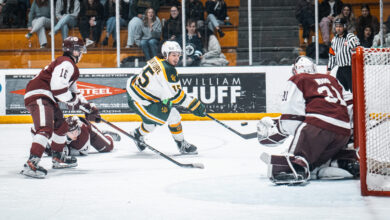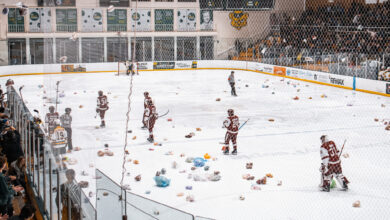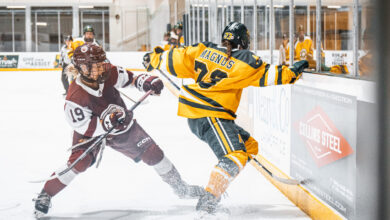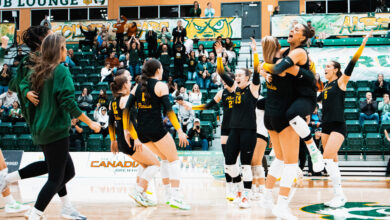Pro signings lay the field of college hockey
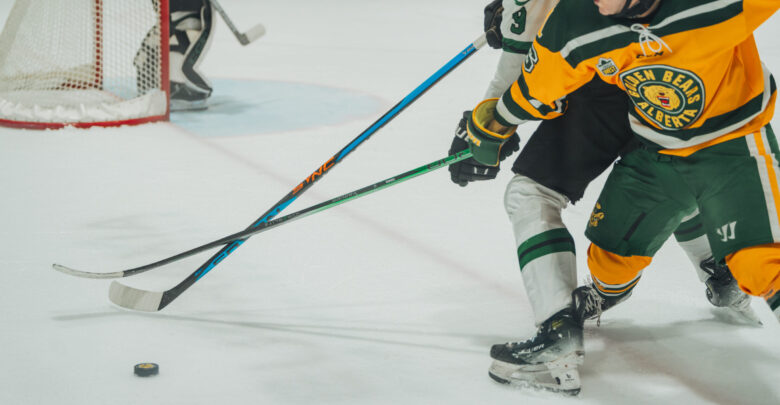 Fair Frames
Fair FramesWhile mid-April brought about the Frozen Four and end-of-March gave fans an entirely shocking U Sports championship, there’s more to be on the lookout for.
It’ll be hard to beat the loss taken by the Hockey East powerhouse known as Boston University (BU) to the not-favoured Western Michigan Broncos. Or the Ottawa GeeGee’s Cinderella storybook ending of 2025 — still figuring out how that happened.
But it’s not over. The games of course are, but pro signings continue to come out as an indication of the fields of college hockey, and what next steps could look like between universities.
If your first thought in the signing department went to Ryan Leonard with the Washington Capitals, Jakob Fowler to the Montreal Canadians, and even Quinn Hutson with the Edmonton Oilers, then you’d be of the majority.
We are of course, excluding Canadian Hockey League (CHL) players.
But let’s not forget of American Hockey League (AHL) signings Mark Estapa to the Laval Rocket, Drew Elliott with the San Diego Gulls, or University of Alberta Golden Bears’ own Josh Prokop to the Bakersfield Condors.
There’s a pattern, we can see it.
To zero in, the Laval Rocket have dipped its hand into National Collegiate Athletic association (NCAA) — Estapa (Michigan), Will Dineen (Yale), Joseph Dunlap (Ohio State). While handing out amateur tryouts to U Sports players — Conner McDonald (British Columbia), Brendon Clavelle, Charles-Antoine Roy, Anthony Poulin, and Bradley Chenier (all from Ottawa) — like it’s an every day occurrence.
Why? You might ask.
Laval’s going to lose top talent to the big club next season and a perusal of the Canadian market, to fill those still needed bottom-six slots never hurt anyone. Nor to does placing released players on a reserve list in preparation for playoffs, if that was ever a motive.
But again, this is just an observation.
To observe a little further, Hutson went un-drafted, lead BU in scoring (23-27-50) this past season, signed with the Oilers in an agreement that allowed him to burn a year of his entry-level contract, and play in this high-demand Canadian market. Not the toughest one, as Hutson will admit, but a few years ago, with 22 less points in one more game (39), playing in any market at this level might not have been as certain.
In a league-lower type of situation, Prokop too went un-drafted, played with the Bears for four years, captained them for two, and found himself on an amateur tryout with the Condors not too long after his college season was over.
The similarities are subtle, but are there nonetheless. The slight difference from 23 to 25, the development factor still so plainly needed, and the question mark looming above the certainty of which pro league — the National Hockey League (NHL), or AHL in Prokop’s situation — can be considered permanently feasible.
The Bears, more often than not, send players off to Europe, while not every NCAA player goes to the NHL — an estimated less than five per cent, per Elite Level Hockey.
So, what is an expected path for the better-than-not prospects?
Top NCAA players? To the NHL they go.
Big boys in U Sports? Set up camp in the AHL, with chances of advancement up and down the league. Hello Noah Philp.
Low scoring players in good NCAA programs? Perhaps those already mentioned? See NHL farm teams for future considerations.
The average player in a high-end U Sports programs? Take the average path to a still pro European team. See Tyler Preziuso, Eric Florchuk, and others.
An off-the-radar U Sports pick, such as Roddy Ross with a 1.96 and 1.99 goals against average in his last two seasons, respectively? Already logged time in the ECHL playoffs.
Less than mentioned NCAA players? Well, they’re not mentioned.
Take the sample for what it is.
To catalogue all the paths one player from any program could take, would feel more tedious than the list that has just been read. But the boxes have been checked, points were made, and the pattern isn’t as clear as initially expected.
The remaining 95 per cent of NCAA players follow a similar path to those in U Sports, towards a different, but respectable brand of pro hockey. While others find themselves in all to familiar situations.
Specifics of pro-signings aside, both Hutson and Prokop will start next season in Bakersfield, playing for the same team, developing in the same environment. And when asked what he hoped to yield out of his two games in the NHL, Hutson replied with a simple, “I just want to show that I can play here” attitude.
Because nothing is as uncertain as player development, or pro rosters.

